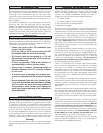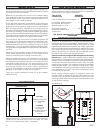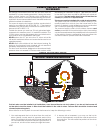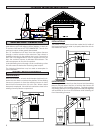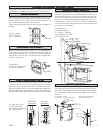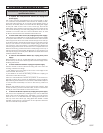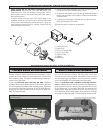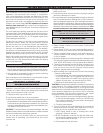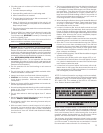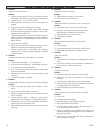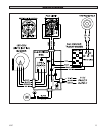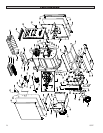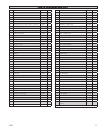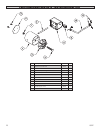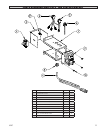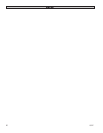
13USSC
DANGER: Risk of Fire or Explosion - Do not burn garbage,
plastics, gasoline, drain oil or other ammable liquids.
Plastics, when burned, form hydrouoric and hydrochloric
acids which will damage and destroy your furnace pipe
and chimney. The burning of trash or oil can result in an
extremely hot re and is sometimes a cause of chimney
res. NEVER BURN GREEN WOOD OR TIRES.
WARNING: Risk of Fire - Do not operate with ue draft
exceeding .06 inches of water column and must be set
with a draft gauge to maintain a steady draft. (Barometric
Damper recommended.)
Do not operate with the fuel loading or ash removal
doors open.
Do not store fuel or other combustible material within
marked installation clearances.
Inspect and clean your ues and chimney regularly.
CAUTION: Hot Surfaces - Keep children away. Do not
touch during operation. Maximum draft marked on
nameplate.
Equip your home with re extinguishers and smoke de-
tectors appropriately located.
Wood should be placed directly onto the cast iron shaker
grate of the Clayton furnace. Do not use additional
grates and/or irons.
Do not allow ashes to build up higher than 2” above
grates.
Never allow the ashes in the ash pan to touch the grate
section. REMOVE ASHES FREQUENTLY!
Be extremely careful when removing furnace ash pan;
it can get very hot.
With new steel, there is a small amount of oil or dirt on
the metal. You may smell an odor. This is normal during
the rst operation. You may want to build a small re in
the furnace to “burn off” this dirt and oil before installing
the duct work.
The furnace is designed to burn air dried wood and coal
at a predetermined ring rate. Over ring could result
in damage to the heat exchanger and cause danger-
ous operation. Over ring occurs when the ash door is
left open during operation or a highly volatile fuel, i.e.
large amounts of small kindling, is used. If any portion of
the connector pipe glows orange or red, you are in an
over-ring situation. Close all dampers.
When tending the rebox always pull the bafe slide rod
out prior to opening load door. Open load door slowly
to avoid a “ash back”. After closing load door, push
the bafe slide rod to the rear.
In event of chimney re, shut all draft controls and call
your re department immediately. Alert everyone in the
house. If the re is still burning vigorously, throw baking
soda into rebox or discharge a re extinguisher into the
rebox. After chimney re is over, completely inspect
system for damage before further use.
NEVER throw water on the re or at the furnace, as rapidly
expanding steam could result in a severe scalding.
Slow res: It is not recommended burning the Clayton
furnace any more than necessary early in the fall and
late spring, as you cannot keep the rebox hot enough
(without overheating your home) to burn gases. Slow
res can cause excessive creosote build-up in smoke
pipe, chimney and rebox.
Inspect air lters regularly. The air lter should be changed
at least every 30 days.
Oil motors every 90 days with a few drops of 30 wt. oil.
Check the t on the load door. It must t tightly. If it does
not, check for deterioration or wear of the ceramic rope
seal. Replace defective seals.
In the event of a power failure, the furnace will not dis-
tribute heat to the home. We recommend the use of a
back-up generator, 2,000 watts minimum, for continued
use until regular power is restored
NOTE: For further information on using your furnace safely,
obtain a copy of the National Fire Protection Association
publication “Using Coal and Wood Stoves Safely.” NFPA
NO. NW-8-1974. The address of the NFPA is 470 Atlantic
Ave., Boston, Massachusetts 02210.
If the re goes out or does not hold overnight, look for:
1. Poor draft.
2. Incorrect damper settings.
3. Improper ring methods for coal being used.
4. More combustion air needed.
5. Coal not sized to the furnace. We recommend 1” to
3” diameter pieces of coal.
6. Ashes, if allowed to accumulate in the ash pit, will
not allow the passage of required air for combustion.
Keep ash pit clean.
7. This furnace is not to be used with an automatic stoker
unless so certied.
There are ONLY two types of coal allowed for use in this
furnace: Bituminous Coal (soft coal) and Anthracite
Coal (hard coal). NEVER USE Cannel (or Channel) coal
or Brown (Lignite) Coal.
See our Bulletin RC454 at the rear of this manual for the
best information available on burning coal.
OPERATING NOTES
THIS IS A WOOD AND COAL BURN-
ING FURNACE AND SHOULD NOT BE
ALTERED IN ANY WAY! DOING SO
WILL VOID YOUR WARRANTY!
When wood is burned slowly, it produces tar and other
organic vapors, which combine with expelled moisture to
form creosote. The creosote vapors condense in the rela-
tively cool chimney ue of a slow-burning re. As a result,
creosote residue accumulates on the ue lining. When
ignited, this creosote makes an extremely hot re.
The chimney should be inspected at least twice monthly
during the heating season to determine if a creosote build-
up has occurred. If creosote has accumulated, it should
be removed to reduce the risk of a chimney re.
CREOSOTE - FORMATION AND NEED
FOR REMOVAL



